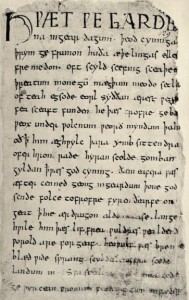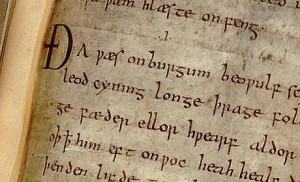Back at the start of the summer, staffer GreenDragon generously asked the publisher Houghton Mifflin Harcourt to send me a copy of Tolkien’s translation of Beowulf to review. While I started the book right away, this review has been delayed by producing Happy Hobbit and attending four conventions, along with writing two books and a script on top of daily life and work, which is a long-winded way to say that I apologize for my tardiness!
While still an undergrad, I took a course in Old English which was an introduction to the language, followed by a semester of translating Beowulf. A year isn’t enough time to master a dead language, and I was attempting to master two at once, for I was also taking Latin at the time (an alternate nickname for me could be Hermione), so I won’t be able to go into the nitty gritty mechanics of the language like Tolkien does in his notes, but I will offer what insight my education allows!

To offer some context, I will say that Old English is the name we have given to the Anglo Saxon language, for after a strong French influence after the Norman Conquest of 1066, Old English morphed into Modern English. It is important to note, as well, that Anglo Saxon is the language of our (even if you aren’t of English descent, you’re reading this in English) conquerors, for the Nordic tribes of the Angles, Saxons, and Jutes invaded England after the withdrawal of the Roman Empire around 410 CE. They renamed the island Angle-Land. England. So while Beowulf is attributed as being the first great epic in English, it is significant that it is a story from the culture that conquered the island and that its setting is in the conquering nation’s homeland in the north, not England, even though the manuscript was recorded and found in an English monastery, hidden beneath pages of religious text. All of this would have been known to J.R.R. Tolkien at the time of his translation in the 1920s.
Firstly, I will say that my reason for taking Old English was driven by my obsession with Tolkien and The Lord of the Rings. I was first exposed to Beowulf in seventh grade when I read a version of the poem for one of my classes. Enamored with the culture and the exciting, heroic tale, it lingered in my mind in a way that few stories read for school had. In the Humanities Honors Program in college, we were exposed to the literature that laid the foundations for Western civilization and I once again read a translation of Beowulf (picturing Aragorn as Beowulf this time around, of course) and while in my proceeding English courses I avoided the works I had already read, Beowulf was the one text I would read every time I was asked. As such, I have been exposed to three or four translations, including my own.
As many of you know, Tolkien is essentially solely responsible for the poem receiving the high esteem it now enjoys. Before the Professor’s 1936 essay “Beowulf: The Monsters and the Critics,” the epic was seen as a curiosity and not a focal point of study. While translating the poem, I searched for Middle-earth everywhere, from the name of Théoden (meaning “leader of people”) to the despoiling dragon being Smaug, to the idea of the poem itself being a dirge for a dying people, like the Line of Durin. Old English is not a complete lexicon, so there are words that exist in Beowulf that don’t (yet) have any meaning to us. It was delightful to find terms like “Earendil,” which has no known meaning, and see how Tolkien’s imagination latched onto it and assigned it a meaning of his own. Like the Professor, I was likewise enamored with the words of the poem, which was why I was surprised, and a little disappointed, by Tolkien’s translation.

In the foreword, Tolkien’s notes/letters acknowledge that he was struggling between doing an academic translation versus one that someone off the street could pick up and get into, which was very understandable for his time. The poem was not yet widely known and in many ways, I think Tolkien felt it was his duty to bring the story to as wide an audience as possible to give the poem more exposure. This was, and is, a noble cause and is ultimately achieved in the translation style he chose. His purpose serves him well in that he offers a flavor of the Anglo Saxon language and culture without it being overbearing, and if it had been published in his era, would have been well-suited for his audience. What his translation lacks, ironically, is the very love of words that we know fueled his imagination.
It is interesting to note that, as a child of the 80s, I was raised in a “Post-Tolkien” world where the genre I would fall in love with most, Fantasy, was stamped permanently by the Professor. Middle-earth and the Anglo Saxon aesthetic that Tolkien brought to his works became the foundation of the genre, and as such, reared fans much more acclimated and accustomed to the real culture of the Anglo Saxon people than they would have been in Tolkien’s lifetime. As such, in a twist of fate, it was the works of Tolkien’s imagination that brought our current readership to a point that, if he were still alive, he could have offered a language-rich translation with little resistance.
The beauty of Old English and the storyteller of Beowulf is the alternative point of view the words offer. For example, blood in the poem is sometimes called “battle-sweat,” blades are called “sword edges,” and the dragon’s gold is “grimly-purchased,” (a means to describe murder). These metaphors, if you will, offer insight into the mindset of the Anglo Saxon culture and their absence is felt in Tolkien’s translation. These warriors of the north were all too well aware of just how transitory and brief life is. This dark aesthetic even weaves its way into the descriptions of Heorot when the poet mentions the fine mead-benches “not yet touched by the fires of war,” exemplifying a “live for the moment” mentality that was common in the Iron Age.
The brooding tone of the epic has always felt like glimpsing a portion of the past with a candle’s flame. Discolored and shadowy, we can only see and touch what the poem shows us, but all the while, we are well-aware that there is a larger world in which our story takes place. Instead of offering us a similar glimpse, Tolkien’s translation presents a story more akin to the language of an Arthurian Romance. It lacks the courtly gestures, of course, but there is something tamed and sanitized in the absence of visceral descriptions like “bone-locks bursting” (joints) and blood that “sprang in streams forth under his hair.” After all, Beowulf is as much a horror story of things that go bump in the night (or eat you whole in the night) as it is a dirge for a passing people.

This, of course, may just be a point of contention between the Professor and I. Through the chivalry of Aragorn and the civilizations of Gondor and Rohan (to say nothing of the pristine Elves), it is clear that Tolkien preferred to let his imagination roam a more civilized, ordered landscape and culture than one that could produce monsters from the fen without explanation. Beowulf is a pagan epic, not Christian, and its religious passages stand out in their awkwardness. It is widely agreed that they were added by the scribe, perhaps as a means to save the exciting tale from a purge of pagan texts. Thus, the explanation that Grendel came from Cain is irrelevant, and it is more grotesque and frightening to view the poem in its original form where evil has no source other than the dark, dank corners of the earth, akin to the dark, dank corners of human consciousness. Tolkien preferred explanations, such as cruelty stemming from greed or lust for power as in the case of Sauron, but the pagan text reflects real life: it is rare that we are left with explanations for evil deeds. It is this visceral, primal element to the poem that stirred my blood, and, possibly, Tolkien’s as well, though he clearly felt the need to channel that stirring into a more tamed expression in his Middle-earth.
That said, just because Tolkien’s translation and epics don’t reflect his affection for the primal words of the poem doesn’t mean his passion for them was absent. I relished the way the poem’s metaphors and kennings made my mind twist and my lips smile over offering a different way to look at words and the world, and I’m certain that Tolkien’s joy exceeded mine. It’s just that very little of that joy is felt through his translation, leaving a strangely bland text where “road” is replaced with the urban term “street,” and the beautiful alliterative passages such as “a grim gruesome guest,” becomes the flat “a dire dragon.”
I must reiterate that my point of view is not only that of a student of Old English who has read multiple translations, rather than a random patron in a bookstore picking up something to read, but also that of a contemporary writer whose imagination has been partially sculpted by the representation of Anglo Saxon culture through Middle-earth. I matured in a Post-Tolkien world. It is ironic, therefore, that I would be critical of Fantasy’s founding father’s translation for an audience that existed Pre-Tolkien, as it were. And even more ironic that, if Tolkien’s translation was the first I’d ever read, I doubt it would have sparked my interest as much as other translations have, and I would never have perused my studies and written this review. Now my brain hurts.
I am interested to hear from those whose first exposure to Beowulf was through Tolkien’s translation and see if his tactic of translating for the “everyman” worked for you. Please share your thoughts in the comments below!
And if this (somehow) wasn’t enough Kili analysis of Beowulf for you (which may indicate that you have a serious psychosis) head on over to TORn Book Club’s episode where I spoke at length on the subject back in August!


